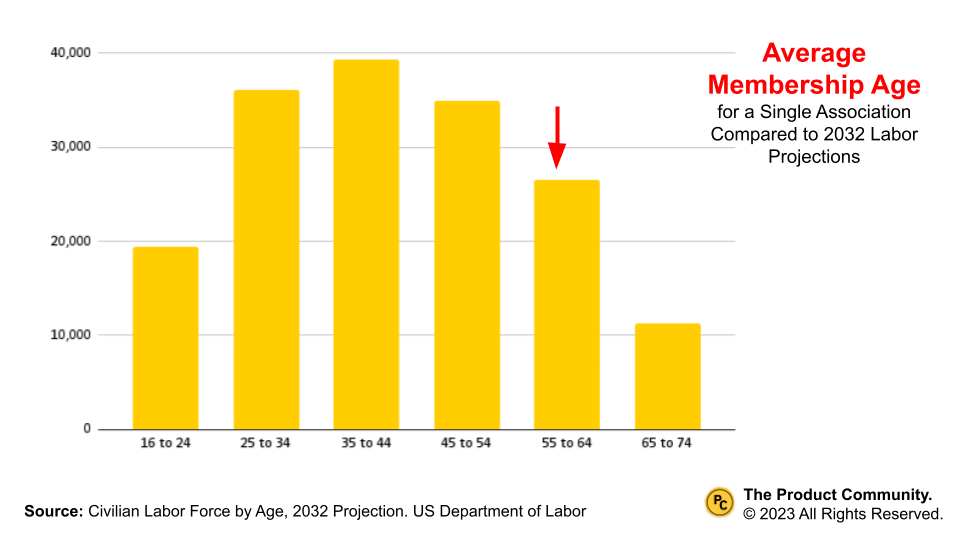Summary
All associations desire to more fully engage the youth market (defined roughly as ages 25 to 35, but sometimes stretching to age 40) yet still operate with an old business model (benefits, membership, events) that continues to draw people in their forties, fifties, and sixties.
The good news? Associations hold the timeless value of connection and the youth market is interested in shared purpose. They do, however, want to engage in vastly new ways.
To achieve growth and relevance, associations need to better understand their market and draw the youth market with a fresh value proposition.
\In this article, I cobble together some simple numbers to tell an unwelcome truth: our average age is up, the percentage of people under age forty who engage is minuscule, and we continue to serve up the same ole, same ole benefits.
The Product Community is a product development learning community designed specifically for associations.
Young Professionals Aren’t Engaging
“Passion, persistence, belief, and ingenuity are required to invent new things, qualities the young have in abundance. Stay hungry.”
Kevin Kelly
We don’t need an enormous amount of data to tell us what’s true. Membership is persistently down and most associations skew toward gray hair, tote bags, and sensible shoes.
I recently worked at a medical society and we persistently struggled to draw med students, residents, or young professionals. I conducted an in-depth market study for another association and learned the following:
Qualifier alert. This is only one association. Still, the facts are clear. We are not proactively strategic about our market, in part, because we rely on squishy missions and visions and traditional business models and governance frameworks.
We serve industries and professions much better than we identify and solve problems that keep us vibrant, relevant, and engaging. Here is a mini-analysis of the above association:
This association has about $1m in revenue and about 4500 members.
94% of revenue is membership or events-driven.
63% of revenue is non-dues.
Average age of membership is 56 (average age of engagement with all products is also 56).
Membership skews older, male, and white.
Average percentage of participants under the age of 40 is between 7% and 8% across product lines.
There is traditional cultural replication via traditional membership models, committees, and volunteerism.
To add some perspective, take a look at this graphic from the US Department of Labor. It places the average age of the above association onto 2032 labor projections.
Membership is down for many reasons. Here are some:
Traditional membership organizations tend not to draw younger professionals.
People want responsive value in an increasingly unpredictable world.
There is negative perceived value for existing benefits, which tend to be traditional.
There is hesitancy to choose membership when for-profit alternatives and easily accessible content is available for free on the Internet.
These problems are common to many associations:
We thrive in community, but our community's needs are rapidly evolving and we’re not keeping pace.
We deliver lots of value, but we struggle to translate ideas into products in a focused and productive way.
We need new revenue, but our business model is inflexible.
We desire innovation, but we operate under constant constraint.
What can we do about it? Here are a few foundational places to start:
Refresh your value proposition. See chapter four in my free ebook Unlocking Growth.
Develop a strategy (not a strategic plan). I recommend Roger Martin’s Integrated Cascade of Choices outlined in my article Playing to Win.
Identify new markets. I recommend the market opportunity navigator outlined in my article Identifying New Markets.
Now, let’s look at how to build off the outcomes of these strategic models. Note: I highly recommend NOT skipping an investment in strategy. The below tactics will have limited success if just ported onto an existing portfolio.
Eleven Ways to Engage Young Professionals
“I want to do what I want to do!”
Henry Wight-Young, age 3
Henry is our son. He just turned 16. We roared when this came out of his precocious mouth thirteen years ago. Initially, I thought, “uh, oh,” but now I think I understand his perspective.
He is just one person, but like anyone of any age, he wants to connect with people who share his interests. He desires to engage in community. However, I can tell he already thinks that the old way is outmoded.
Time keeps moving and things continue to change.
Markets evolve, new markets emerge, member needs change, and young professionals have different cares and wants. Plus, external forces are often beyond our control.
I don’t want to make substantive claims about generational cliches, because we generally respond to them in tactical ways by porting new services onto an existing model.
I argue for a more strategic investment in which we leverage our inherent strengths (we are communities of connection, we serve niche markets without a lot of traditional competition, and we create an enormous amount of underutilized content).
Building on a refreshed value proposition, investment in strategy, and ongoing engagement with the market, here are eleven ways to focus our energies, resources, and capabilities.
Focus on New Models of Engagement. Embrace innovative ways to involve younger members by introducing fresh approaches to participation, such as virtual events, gamified experiences, and digital platforms that resonate with their preferences.
Focus on Purpose. Highlight the association's meaningful mission and its potential to make a positive impact on the world. Showcase how young professionals can align their personal values with the association's goals.
Focus on Connection. Create opportunities for networking and relationship-building, both within the association and with industry peers. Foster a sense of belonging and community among younger members.
Focus on Organic Leadership Opportunities. Empower younger members to take on leadership roles and responsibilities within the association. Provide avenues for them to develop leadership skills and contribute to decision-making.
Focus on Opportunities to Contribute and Shape the Future. Showcase how younger professionals can actively participate in shaping the association's direction and initiatives. Encourage their input and ideas for meaningful change.
Focus on Longitudinal Journeys. Design a member journey that spans a professional's career, offering value and growth opportunities at each stage of their development, from entry-level to seasoned professional.
Focus on Bite-Sized Learning. Offer easily digestible, on-the-go learning experiences that cater to the busy schedules and shorter attention spans of younger members. Develop and deliver microlearning and short-form content.
Focus on Reigniting What It Means to Volunteer. Redefine volunteering as a dynamic, impactful experience that goes beyond traditional roles. Showcase how volunteering can lead to personal growth and professional development.
Focus on Bi-Directional Mentorship. Promote mentorship programs that encourage the exchange of knowledge and insights between younger and more experienced members, fostering mutual growth and learning.
Focus on Value, Not Benefits. Communicate the intrinsic value of association membership, emphasizing how it can enhance a young professional's career, skills, and knowledge, rather than just listing perks.
Focus on How Learning is Contribution. Highlight how learning and personal development can contribute to the association's goals and the industry as a whole. Encourage members to view their education as a form of active contribution.
In future articles, I will continue to dig deeper into what draws younger audiences and how we might position our associations for a new reality.
Membership is an Outcome
“Too many prefer gentle lies to hard truths.”
Shane Parrish
Without equivocation, membership should never be a goal. Membership is always an outcome.
The thriving association relies on focused action, healthy community, and robust engagement. We remain an animal of connection. Young professionals want to shape their professions in ways that the old pecking order ignores at its own peril.
The product community has been designed with value creation at its heart. This value is focused exclusively on a market hungry for perpetual connection, relevant content, and engaging experiences.
Product-led growth fuels connection. Join the product community and flip your destiny.
About the Author
James Young is founder and chief learning officer of the product community®. Jim is an engaging trainer and leading thinker in the worlds of associations, learning communities, and product development. Prior to starting the product community®, Jim served as Chief Learning Officer at both the American College of Chest Physicians and the Society of College and University Planning.
Please contact me for a conversation: james@productcommunity.us.







